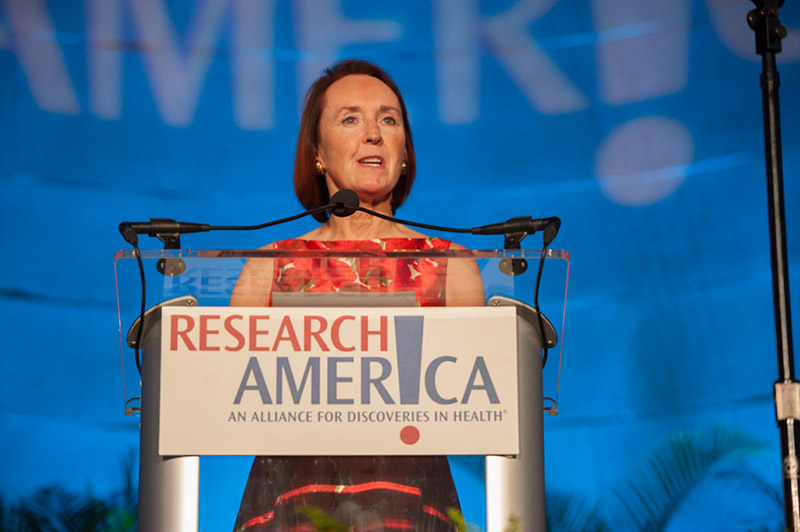Changing the Lexicon

Dear Research Advocate:
Happy Thanksgiving Week! I’m writing early to give us all a holiday. Last Thursday and Friday, l capped off a week of visiting our members at the McKnight Brain Institute (MBI) and the Health Science Center at the University of Florida. Research!America Chair Emeritus, and former member of Congress, the Honorable John Edward Porter, joined me at a Town Hall session during which students, postdocs, faculty, and administrators asked about the best ways to make the case for research with the current and new Congress. At MBI we heard patient advocate extraordinaire Jennifer French, Neurotech Network Executive Director, forcefully articulate the importance of a needed “culture change” to consider patient engagement much more deliberately – indeed, scientifically – in order to meaningfully engage patients.
MBI Director Todd Golde, MD, PhD, spoke of putting science to work to “change the lexicon” about disease – away from words like untreatable and inevitable, to treatable, curable, and preventable. It reminded me of the message framing that Mr. Porter recommended at the Town Hall: Then/Now/Imagine. It’s an easy and powerful way to help people connect the dots and align with the science community in shared aspiration for a healthier future. Click here for a few examples to guide you in developing your own T/N/I message frame.
Today, we released our 2018 report on “U.S. Investments in Medical and Health Research and Development.” The accompanying release notes that unless we pick up the pace we will soon fall behind the curve globally and — even more worrying — we will bankrupt the nation as we fail to keep pace with public health need. As Research!America Chair, the Honorable Michael Castle says, “Overall, U.S. investments in health-related research and development continue to move in a positive direction, but it’s important to consider whether this investment is enough to overcome health threats that are taking lives, reducing productivity, and single-handedly placing our fiscal future at risk.” We spend just 5 cents of every health dollar on research for new treatments, cures, and preventions for illness. We need advocacy now more than ever if we are to achieve the multi-pronged goals of investing in research and innovation.
Every year we look forward to Public Health Thank You Day (PHTYD), on the Monday before Thanksgiving, for a concerted opportunity to thank and celebrate the people of public health who work tirelessly to confront serious health threats every day. Along with 61 partner organizations — and many others on social media — we expressed our appreciation and gratitude for a workforce that improves the health and well-being of those in our nation and throughout the globe, every day. #PHTYD generated a lot of buzz; the hashtag even trended on Twitter! Leaders including HHS Secretary Alex Azar, CDC Director Robert Redfield, NIH Director Francis Collins, and U.S. Surgeon General Jerome Adams spoke out in recognition of public health heroes.
The opioid epidemic provides a clear example of the importance of public health. Facing down the opioid epidemic requires smart work across the continuum of research and clinical professionals, including those conducting health services research (HSR). HSR can make all the difference, since in the absence of evidence for which interventions work, we are wasting time and money and jeopardizing too many lives in what can amount to a scatter-shot approach to ending this scourge. Since the R&D continuum falters without an evidence-based delivery component of the “discovery, development, delivery” paradigm, a new National Academy of Medicine report is especially timely. It holds important insights for the research community and every stakeholder who is looking to research to change the lexicon of hopelessness and intractability to one of health and prevention.
If you’ve been working to end the opioid epidemic, or are following it with an eye to finding answers, you might consider this draft report from NIH on opioid R&D: “Health Research and Development to Stem the Opioid Crisis: A Federal Roadmap.” The report highlights seven areas of opioid R&D and gives research recommendations for each area. The NIH requests comments by December 5.
Very best Thanksgiving wishes to you and yours from all of us at Research!America.
Sincerely,
Mary Woolley




